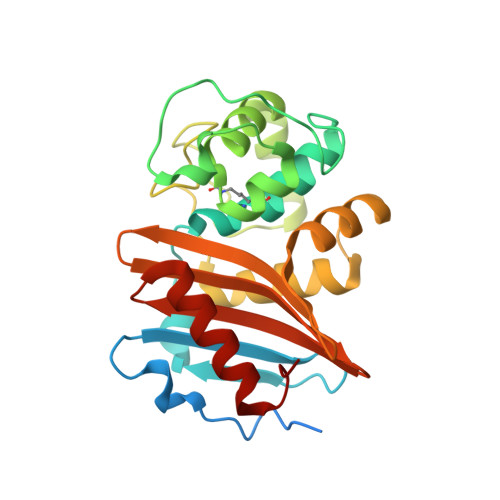A surface loop modulates activity of the Bacillus class D beta-lactamases.
Stewart, N.K., Bhattacharya, M., Toth, M., Smith, C.A., Vakulenko, S.B.(2020) J Struct Biol 211: 107544-107544
- PubMed: 32512156
- DOI: https://doi.org/10.1016/j.jsb.2020.107544
- Primary Citation of Related Structures:
6W5E, 6W5F, 6W5G, 6W5O - PubMed Abstract:
The expression of β-lactamases is a major mechanism of bacterial resistance to the β-lactam antibiotics. Four molecular classes of β-lactamases have been described (A, B, C and D), however until recently the class D enzymes were thought to exist only in Gram-negative bacteria. In the last few years, class D enzymes have been discovered in several species of Gram-positive microorganisms, such as Bacillus and Clostridia, and an investigation of their kinetic and structural properties has begun in earnest. Interestingly, it was observed that some species of Bacillus produce two distinct class D β-lactamases, one highly active and the other with only basal catalytic activity. Analysis of amino acid sequences of active (BPU-1 from Bacillus pumilus) and inactive (BSU-2 from Bacillus subtilis and BAT-2 from Bacillus atrophaeus) enzymes suggests that presence of three additional amino acid residues in one of the surface loops of inefficient β-lactamases may be responsible for their severely diminished activity. Our structural and docking studies show that the elongated loop of these enzymes severely restricts binding of substrates. Deletion of the three residues from the loops of BSU-2 and BAT-2 β-lactamases relieves the steric hindrance and results in a significant increase in the catalytic activity of the enzymes. These data show that this surface loop plays an important role in modulation of the catalytic activity of Bacillus class D β-lactamases.
- Department of Chemistry and Biochemistry, University of Notre Dame, Notre Dame, IN, USA.
Organizational Affiliation:



















